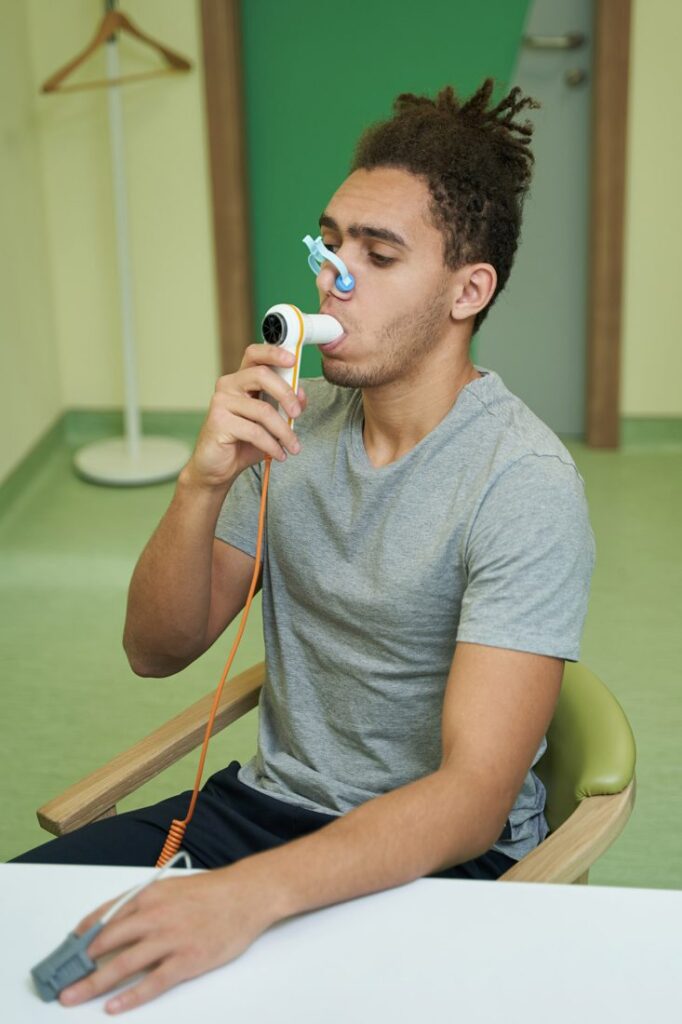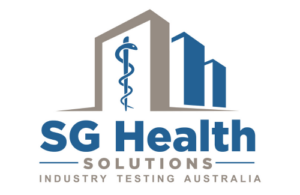Spirometry Testing (Lung Function Testing)

Why not establish a baseline result for your worker and then a monitoring schedule in a similar way to hearing screening?
Spirometry screening is used as a tool to determine a person’s lung performance. Parameters such as age, weight, ethnicity, and if you’re a smoker will be entered into the software. These criteria will then be taken into account when the lung function test is performed. With all this information entered, the screening result produced will be in the person’s defined range, or if there is a loss, this can then be followed up by the person’s preferred medical practitioner.
Spirometry screening may detect conditions such as occupational lung disease, occupational asthma, or chronic obstructive pulmonary disease (COPD). As an initial and ongoing method, you will be able to detect abnormalities with your worker even when no other signs or symptoms may be evident. Therefore, the earlier the intervention, the earlier treatment can be sought, and finally, reviews of work practices can take place, such as appropriate PPE, training, etc.
Where the workforce is potentially exposed to known contaminants such as irritant dust, gases, and vapours, a health surveillance program will keep work-related respiratory concerns to a minimum.
Spirometry Testing FAQs
Spirometry is a non-invasive test that measures if there has been any narrowing of the bronchial tubes. This is done by measuring your lung capacity against the known lung function values for someone of the same age, height, weight, sex, and ethnicity as you.
The spirometer measures the amount of air in your lungs and how fast that air can be expelled. This provides an indication of how well your lungs are performing. Knowing these parameters, the spirometry test can identify if your spirometry results fall into the normal range category or indicate a restriction or obstruction of the airways.
If a restriction or obstruction is detected, medical advice should be sought by your preferred medical practitioner.
Spirometry is an important test used to diagnose and monitor a person’s general lung health and condition. Lung problems can cause narrowing of the bronchial tubes (or airways), resulting in shortness of breath. The greater the narrowing of these tubes, the more difficult breathing becomes. Spirometry is an excellent way to measure the lung condition of a person who may be exposed to elements in the workplace that have the potential to affect their lung health.
Yes. Spirometry is a non-invasive means of measuring a person’s lung condition. It is performed on people of all ages. The alternative means of assessing a person’s lung condition is through the use of a chest x-ray. Any x-ray, when performed repeatedly, can have an adverse effect on a person’s health. This is why an x-ray is usually only recommended when an issue is detected during the spirometry test. The only time that spirometry is not recommended is if you have a medical condition that would make it difficult or uncomfortable to breathe in fully or blow out with force. This includes things such as a recently cracked rib, a collapsed or perforated lung, or recent surgery.
The results obtained are kept on file and used as your baseline, to which all future spirometry tests will be compared. If any deterioration in the results is observed in future tests, you may also be referred to a GP for further assessment and investigation of the results.
The spirometry results are treated in the same manner as all medical records and are not made available to anyone other than you and the persons responsible for monitoring your health in your company.
Having a spirometry test is straightforward. The test involves taking a full breath in and then blowing it out as hard and as fast as you can into a tube attached to the spirometer machine. Various measurements will indicate how your lungs are working. The test is performed while seated and usually takes around 10 minutes.
In higher-risk industries such as mining, manufacturing, construction, pharmaceuticals, and healthcare, we recommend an audit as part of pre-employment or onboarding checks and then periodically (for example, annually). It is vital for employers to monitor the potential impact of possible exposure to hazards such as dust and airborne chemicals.
Breathe in as deeply as you can.
- Bring the mouthpiece up to your mouth.
- Seal your lips around the mouthpiece.
- Blow out as hard and as fast as you can.
- Keep blowing out as long as possible—usually around 5 seconds.
The test will usually be repeated three times to ensure a consistent and accurate result.
The spirometrist will talk you through each test procedure and give you immediate feedback on your performance. They will then fully explain the results to you and, in most cases, give you a printed copy of the spirometry report.
Other Services
Drug & Alcohol testing
Reduce workplace risk and maintain a safe working environment for your team through effective alcohol and drug screening.
DAMP Policy
Effective alcohol and drug screening can reduce workplace risk and maintain a safe working environment for your team. SG Health offers onsite drug and alcohol screening using either saliva, oral fluid, or urine, accompanied by a breathalyser test.
Spirometry (Lung Function)
Employees who are potentially exposed to irritant dust, gases, or vapours in the workplace should be tested.SG Health provides onsite spirometry tests to assess and monitor employees lung function.
Respirator Fit Testing
Protect your team from chemical, environmental, and airborne biohazards. Respirator fit testing by SG Health will ensure your respirators are safe and up to code. and your employees know how to wear the devices properly.
Audiometry (Hearing)
Audiometric testing is required in any working environment where employees have exposure to noise levels that require a hearing protector. SG Health will determine each worker’s baseline and provide periodic audiometry testing to ensure you are meeting your legislative requirements.
Wellness Check
A tailored solution that promotes workplace health, including cholesterol, diabetes, and skin cancer checks.
Impairment Officer Training, HLTPAT005, and Educationals
Specialised training programs, including Impairment Officer Training and HLTPAT005 certification, equipping individuals with the skills to conduct workplace drug and alcohol testing while providing educational services to promote drug and alcohol safety and compliance in the workplace.
Medical and Paramedical
A comprehensive range of medical and paramedical services aimed at meeting the diverse needs of your clients. Our commitment is to deliver efficient, discreet, and compassionate care while minimizing any disruptions to their busy lives. Whether it’s a complete medical examination or specific tests, we offer expertise and professionalism to meet their requirements.
Get an Online Quote

